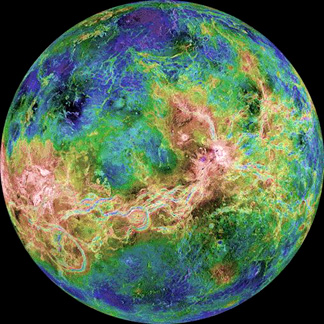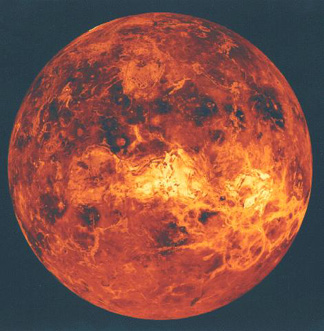
One of the supreme triumphs of planetary exploration is the Magellan program developed and run by the Jet Propulsion Laboratory to study Venus close-up by penetrating its cloud cover. The first spacecraft ever launched from the Space Shuttle (Atlantis), on May 4, 1989, to another planet, Magellan's primary instrument was a multimode Radar Mapper (2.385 Ghz; 12.6 cm wavelength). In the SAR imaging mode looking between 18 and 50 off-nadir, it could visualize scenes with resolutions between 360 and 120 m (1181-394 ft) depending on position within its elliptical near-polar orbit (at altitudes between 275 and 8443 km (171 - 5243 miles beyond a mean venusian radius of 6051 km [3758 miles] ) first established on August 10, 1990 after 1 1/2 loops around the Sun. Its altimeter mode achieved a vertical accuracy of better than 50 m (164 ft) within a ground cell of 10 km (6.2 miles) diameter. Operating in a radiometer mode, the radar could sense surface radio emission brightness temperatures with an absolute accuracy of ± 20° K. Information on mass distribution (causing gravitational anomalies) was gleaned from Doppler frequency variations due to gravity effects that change orbital speeds. Even as Venus rotated slowly beneath (one complete day every 243 earthdays), during stages of orbit closer to the planet the radar imaged surface swaths between 17 and 28 km (10.5 - 17.4 miles) widths. Through the first cycle lasting 8 months, 84% of the surface was mapped; in the next 16 months that percentage rose to 98%. Additional coverage provided repeat looks in search for possible transient or short-term changes. After several adjustments to lower orbits, the spacecraft finally burned up in the venusian atmosphere in mid-October, 1994.
Image strips covering thousands of kilometers, especially after being joined as mosaics, provide stunning views of a fascinating venusian surface that is still undergoing thoughtful interpretations. Although Venus no doubt was formed concurrently with Earth, its surface today is considered to be largely younger than one half billion years (Earth has some surficial regions older than 2 billion years). This estimate is based on crater frequencies; even though not uncommon, the numbers of resolvable impact structures are consistent with 1) destruction of the much larger numbers likely to have developed in the first 4 billion years, most probably by active processes that removed them by lava overplating (resurfacing) and by still arcane erosional actions, and 2) asteroidal flux rates for the last 500,000,000 years in line with estimates from other planetary surfaces. Effects of volcanism are conspicuous; thousands of small volcanoes have been detected along with many lava channels. Although fracture zones and sets of close-spaced "ridges" are evident, no direct indications of terrestrial-like plate tectonics were discerned. Surface water, if ever present, left no signs of stream or ocean activities, and would have largely escaped from the planet (traces are present in its atmosphere) as Venus heated up until a massive "runaway greenhouse" warming effect is now the state. The slowly rotating atmosphere seems to have caused some wind streaks and dunelike deposits on the surface.
The gallery of Magellan images is vast. We show only a select few here but you can access more at JPL's Magellan Home Page (http://www.jpl.nasa.gov/magellan/).
We present first a color-coded relief map of nearly all of Venus, on a mercator-like projection, derived by integrating imaging and altimeter data.

Blues represent the lowest surfaces followed by greens, then yellows and oranges with red being highest. The greatest elevations are within Maxwell Montes (top left), that includes the high point of the uplands known as Ishtar Terra. Another high region, near equatorial center, is Aphrodite Terra. Beta Regio, near central left, is also elevated. Two blue regions in the north are low plains called Sedna Planitia, below Ishtar, and Atalanta Planitia well to its east. A large curved channel south of Aphrodite is known as Artemis Chasma.
Now look at a hemispherical projection that lies within this full map. Try to identify the high central region (in pink), enlarged from the first map (hint: think of a lovely goddess).

This same hemispherical segment can also be displayed (below) as a quasi-natural color image of a mosaic of rectified Magellan scenes. There is no direct proof that Venus has this much red (choice of assigned colors was a rather arbitrary best guess) but, if so, the presence of oxidized iron could account for such tones. The dark, blackish low areas are presumably basalts.

Code 935, Goddard Space Flight Center, NASA
Written by: Nicholas M. Short, Sr. email: nmshort@epix.net
and
Jon Robinson email: Jon.W.Robinson.1@gsfc.nasa.gov
Webmaster: Bill Dickinson Jr. email: rstwebmaster@gsti.com
Web Production: Christiane Robinson, Terri Ho and Nannette Fekete
Updated: 1999.03.15.